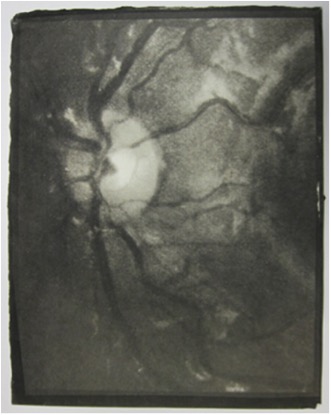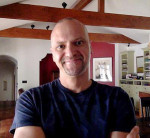
Charles Grogg
American, 1966-
New Moon, 2011
platinum print
sheet 15 x 11 ¾ in.
SBMA, Museum purchase with funds provided by PhotoFutures
2012.19.4a

Charles Grogg at home
“Photography is a documentary medium if used properly. Sometimes, I think that I am really abusing photography.
My oldest son has been traumatized by his mother, a borderline personality who has alienated and estranged him from me as a way of covering for her own losses and frailties she cannot examine. The court system is slow to act, and perhaps rightly so: in the complex psychological games played by the borderline, only in time and through consistent patterns can the agency of the sick relationships be identified. My work is about loss, about waiting, and about tempering anger to fit the pace of the unfolding resolutions, but without that anger losing touch with its source.
Because the world is always moving and photography acts to obliterate its subject into artifice or to size it up for extraction and extrapolation, it may be that the imagined present, one that is defined by agency, is all we have. The past and future are real to us, but it may be that photography marks the world’s only notion of the present. The world is not finished and whole, and the photograph points to it not so much as an index as a possibility. It is the destruction of motion and reconstruction of possibility that I prefer to explore."
- Charles Grogg
COMMENTS
Charles Grogg is known internationally for his fractured photographic images. Printed in silver or platinum/palladium on handmade Japanese paper, he stitches their components together with tethers, sutures or other three-dimensional material. The resulting works address issues of growth and restraint, hesitation and power.
The poet and photographic historian John Wood observes: "Charles Grogg’s photographs are hauntingly beautiful. And they are strange… Strings and wire are often an integral part of a Grogg photograph… wire, string, tendrils, roots, veins, all the connecting tethers of life, become his metaphor... Where, one might ask, is the beauty of a mud dauber wasp’s nest, a stapled envelope, a cracked egg, or a woman with a tree’s roots on her head? It is all in the making. The very fact that Grogg can make beautiful photographs of such subjects speaks to the selectivity of his eye and the power of his craft."
Born in 1966 in Gary, Indiana, Grogg did not become interested in photography until 1999. His interest was spurred by a gift from his father, a Leica camera purchased in 1954 in Germany. He describes the years 1999-2005 as his apprentice period — a time spent studying and reading about photography, going to art exhibitions and teaching himself black and white film techniques.
While Grogg is primarily self-taught, an independent study with Bill Hendricks at Ventura College in California allowed him to use the college’s darkroom and studio. He gave himself a technical education by studying and copying the techniques of Michael Kenna, Ruth Bernhard and Flor Garduno.
Grogg employs both traditional and digital photographic techniques to achieve his imagery. He uses black and white film, currently preferring Ilford FP4 Plus in 4x5 and 120 sizes. Polaroid 55P/N, a film once favored by Ansel Adams, was also a favorite of Grogg’s before it was discontinued. A Hasselblad 501 and a DLC Canham — a handmade aluminum 4x5 field camera — are his current cameras of choice. He says, “Because I tend to be hyperactive, I like the stillness of the 4x5 camera.”
Four images from his recent series After Ascension and Descent were shot using an Epson V750 Pro scanner as the camera. The image titled “Repair,” which depicts a feather in a vise grip, was shot by turning the scanner on its side. Other images photographed using the scanner are images of a cracked egg, a wasp nest and a snakeskin.
Grogg’s first photographs were silver gelatin prints, split-toned with light sepia and heavy selenium toners. The split-toning gave a blue tint to the highlights and a brown tint to the shadows. He was inspired to try platinum printing after seeing Ruth Bernhard’s images at Photo LA, printed by Michael Kenna. Grogg’s platinum/palladium prints are contact prints made on Japanese Gampi Torinoko, a handmade paper no longer produced due to the maker’s death. Grogg starts with a digital negative created by scanning the original film negative. The scan is printed on Pictorico, a transparency material, on an Epson 3800 printer. This printed output serves as the digital negative, which he places in a contact frame, sensitizing the paper with iron salts and platinum/palladium salts. He then exposes the paper using the sun.
From the beginning, Grogg has grouped his photographs as part of a series, and he considers his first four series to be apprentice work. His first series consisted of diptychs in which a nude photograph was paired with a photograph from the natural world. The images were intended to be viewed as parallels, matted side by side in a single frame.
The images in Grogg’s next series, Sent from the Garden, were botanical still lifes. He chose to photograph plants, leaves and flowers because he wanted to experiment with light. The botanicals were all photographed under the slatted eaves of his house, which gave a diffused light. While the subject matter is readily found in southern California gardens, it appears much more exotic in Grogg’s silver gelatin split-toned prints.
Metempsychoses is a series of single-stem flowers that appear to be in motion. In reality, Grogg achieved the illusion of motion with multiple exposures in a single frame. The dictionary definition of “metempsychoses” is: “the supposed transmigration at death of the soul of a human being or animal into a new body of the same or a different species” — or, more simply stated, reincarnation. He printed the 20x24 inch platinum/palladium prints on cotton rag paper.
Grogg considers his series Reconstructions, created from 2008 to 2010, as the beginning of his mature work. Its theme applies to much of his output: “I am looking at myself, at the problem of being contained and growing out of places and being restrained somehow and being afraid.” Reconstructions is composed of nine sections taken from the original negative; these sections are printed as individual platinum/palladium prints on Gampi Torinoko, then sewn together with thread on a 28x36 inch piece of Japanese washi to make the final print, which mirrors the original negative.
The images of his most recent series, After Ascension and Descent, were all shot during a three to four week period in 2010. The original 20x24 inch silver gelatin prints were exhibited at wall space gallery in Santa Barbara in October 2010. Crista Dix, owner of wall space, writes in the accompanying catalog:
"Charles Grogg’s work is complicated...Physically, Charles is not content to create a simple photographic print.... With photography as his base, he adds layers using wax, mud, oils, and thread...Texture is his modifier, used as a connector and emotional bond. This particular body of work, Ascension, examines the ties that bind us. Objects, ideas, people. Not content with the visual clues hidden in the images, Grogg adds his binding threads reminding us of what we have gained in connection yet potentially lost in our freedoms. The give and take of commitment, of stability and permanence."
In reference to his use of mud and oil as a medium, Grogg says, “The thing about being self-taught is you can be inventive and put things together. Why the hell not?” After Ascension andDescent takes the rhizome as its metaphor. Grogg says, “Rather than thinking being about something starting at the base and growing like a tree... thinking is like a fern, putting out roots horizontally, all at one level... I am …looking to find where the stem is.” The series includes images of two baseballs: one with the exterior cover peeled back, and the second cut further to reveal the innards. The titles, which come from the famous poem “Dover Beach” by Matthew Arnold, are “The World Which Seems To Lie Before Us (Bound)” and “The World Which Seems To Lie Before Us (Unbound).” Grogg explains, “I found an old baseball and cut it open … to get a feeling or understanding of something larger than the baseball. I don’t care about the baseball. I like it because it is round and it looks like a world, a world that has all these tethers around it. I start cutting through those tethers.”
The image titled “Full Moon” was taken from a medical scan of his son’s right optic nerve. Grogg says, “It is horrifying to look behind a full moon.” John Wood comments, “‘Full Moon’ seems to unite one of Odilon Redon’s (a French symbolist painter) most disturbing eyes with one of his worst spiders.”
Grogg has taught college English for twenty years in southern California. He describes his work as teaching people how to think—how to have complete thoughts. His teaching career and reading interests explain his use of literary references in titling his series and individual photographs.
21st Editions recently published Cracked: The Art of Charles Grogg. The book is a bound volume of 10 original 11x14 platinum/palladium prints and three loose 20x24 inch prints from Reconstructions. John Wood wrote 11 poems and an essay for the book, which is available in a limited edition of 38 copies. 21st Editions has published books and portfolios by other noted photographers such as Sally Mann, Greg Gorman and Arthur Tress. Grogg says, “Doing the production work on approximately 400 platinum prints for this book made me a better printer. But paradoxically, I mastered a skill that became instantly obsolete when the paper was discontinued.”
Grogg claims that he was 21 years old before he visited a museum. One art influence that he cites is the 1988 exhibition of German Expressionists at the Los Angeles County Museum of Art. He has been influenced by the photographic work of Andreas Gefeller, Keith Carter, Robert Mapplethorpe, Josef Sudek, Hiroshi Sugimoto, John Dugdale, Joyce Tenneson and James Casebere. Grogg also likes documentary work, especially James Nachtwey’s, which he absolutely feels is art.
Grogg says, “Photography is a documentary medium if used properly. Sometimes, I think that I am really abusing photography.” But the recognition that he has received in his relatively short photographic career is an indication that he is far from abusing photography. Rather, he is using photography to communicate metaphorically the inner workings of his mind — feelings that are shared by many even if not expressed.
- Nell Campbell, The World of Charles Grogg, Photographer’s Forum, Winter, 2011
SBMA CURATORIAL LABELS
In this mysterious image by Charles Grogg, the veins of the universe appear to bring life to a bourgeoning moon. The shadowy realm depicted in Grogg’s print however, is far removed from the wonders of the galaxy; for it is in actuality the retina of his son’s eye. As a platinum print, the silvery gray tones of the retinal image are further enhanced by the rich texture of the handmade paper. This photograph is part of a portfolio series titled Cracked, in which Grogg experimented with the possibilities of the platinum photographic process to create ethereal images that intersect art and science. Grogg, a Santa Barbara artist, recently wrote: “This image exposed a private, internal, and vital system of physical connections into the waking world, so it is at least as much about photography itself as it is about anything. I recall Karen [Sinsheimer]’s rapt attention to images I printed in monochrome that looked unreal—abstract or fabricated but with subjects that were really there.”
- Ridley-Tree Gallery, 2016
